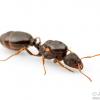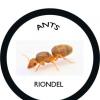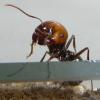Formica with terrible grip? When I caught my queens I needed to wait for my test tubes to arrive so I left them in a container with a baby powder barrier and I found some roaming around the floor randomly the following day. One even made its way into my shirt somehow...
This is just from my experience, and only with F. subsericea. F. subsericea queens just seem extra clumsy (especially when fattened up or are about to lay eggs).
Well That’s great!! She can barely climb on the side of the test tube without falling off. She has been cleaning her taster A LOT so I hope that means baby ants soon! Fingers crossed





















